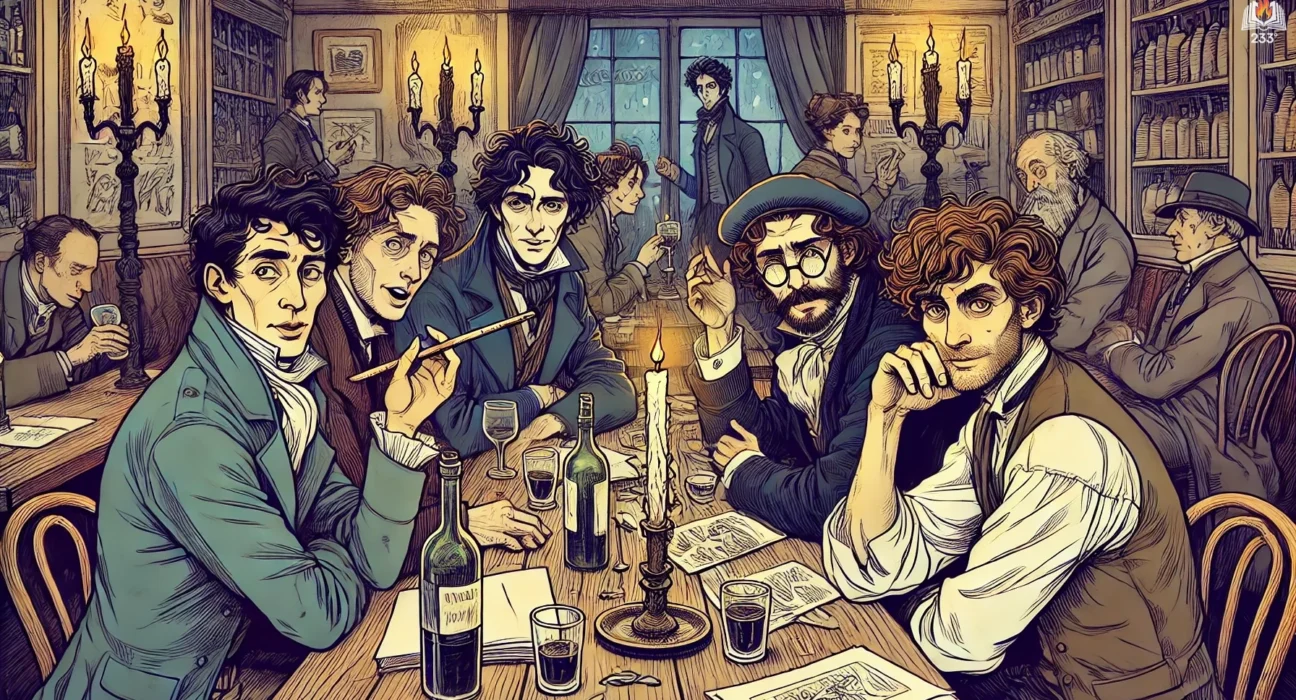Bohemians of the Latin Quarter (originally Scènes de la Vie de Bohème) by Henri Murger, first published in 1849, is a significant literary work that offers a vivid portrayal of bohemian life in 19th-century Paris. The novel explores the experiences of young artists, writers, and musicians who live in poverty while pursuing their creative passions. Murger, having lived this lifestyle himself, presents a humorous yet poignant look at the romanticism and hardships faced by bohemians in the Latin Quarter. This book is often credited with establishing the archetype of the struggling artist, and its influence has been widely felt in literature and the arts, most notably inspiring Giacomo Puccini’s opera La Bohème.
Plot Summary
On an early April morning, the sun streamed into the small garret of Alexander Schaunard, an eccentric musician and painter, waking him from his sleep. He was surrounded by the remnants of a bohemian lifestyle—unpaid bills, a makeshift bed, and his beloved piano, the only sign of his artistic pursuit. The harsh reality of an eviction notice looming over him forced him into action. He had only hours to gather seventy-five francs to pay his landlord, Monsieur Bernard, and avoid being cast out onto the streets. Schaunard’s method for survival was as unconventional as the man himself. He danced, sang, and played his piano in a frenzy, hoping for inspiration to strike like lightning. Eventually, he resigned himself to venture into the city to try his luck and ingenuity in raising the money.
Schaunard’s day of hustling through Paris was a reflection of the unpredictable life he led. He had long mastered the art of borrowing money, with an elaborate system of friends and acquaintances from whom he could extract small sums to keep him afloat. His method was precise, noting when his friends might have a few spare coins, but this day his efforts yielded a meager three francs. Desperate, he roamed the streets, trying to find shelter for the night, and decided that if all else failed, he would rely on the unpredictable kindness of fate.
While Schaunard wandered, a young painter named Marcel moved into Schaunard’s soon-to-be-vacated apartment. Marcel, whose ambitions were as grand as his talent, arrived with only painted theater backdrops and a bare easel, his only possessions of value. His past love affair with the flirtatious Musette had left him both heartbroken and driven, though his art never seemed to sell. After moving in, Marcel spent much of his time in melancholy reflection, often thinking of Musette, who had left him for a wealthier man.
Rodolphe, a poet whose imagination knew no limits, was another close friend in their bohemian circle. Rodolphe’s love life was as dramatic as his writings, and his affair with a young woman named Mimi was a tempestuous one. They were both passionate and idealistic, but the realities of poverty created cracks in their relationship. Despite their love, their struggles to survive often led to bitter arguments and separations. Still, Rodolphe’s heart was ever hopeful, and he wrote poetry in honor of Mimi, idealizing her as his muse. Yet, beneath this romanticized veneer, both knew their life together was hanging by a thread.
Another member of their bohemian group, Colline, was a philosopher who owned nothing but books. His passion for intellectual pursuits and his philosophical musings kept him apart from the material world. His coat pockets bulged with manuscripts and old volumes he could not part with, even if it meant going without food. Colline’s spirit, however, was always buoyant, content to live in poverty as long as his mind remained rich with ideas.
The group of friends often gathered in cafes, enjoying each other’s company and discussing their artistic dreams over cheap wine. They were always short of money but rich in camaraderie, lifting each other’s spirits in times of despair. Marcel, Rodolphe, Schaunard, and Colline lived in a world of contrasts—between their boundless artistic ambitions and the harsh reality of hunger, cold, and unpaid rent. Yet, they faced these hardships with humor and defiance, finding moments of joy even in the smallest victories, such as when they managed to pay for a meal or keep a roof over their heads for another month.
As winter settled in, their lives took on an even more desperate tone. Mimi, whose health had begun to decline, often took refuge with Rodolphe, but their happiness was short-lived. Rodolphe, aware of his inability to provide for her, suggested they part ways for the sake of her well-being. Mimi, though heartbroken, agreed, and their parting was filled with sorrow as both knew they still loved each other deeply but could not continue to live together in such dire circumstances.
Meanwhile, Marcel and Musette’s relationship also took another turn. Musette, ever the free spirit, returned to Marcel after leaving her wealthier lover, claiming she could not live without him. Their reunion was passionate, but like all their past encounters, it was riddled with jealousy and fights. Musette, who loved the finer things in life, found it difficult to adapt to Marcel’s life of poverty. Their love, like that of Rodolphe and Mimi, was vibrant but doomed by the brutal hand of poverty.
As the year wore on, Mimi’s health worsened, and Rodolphe’s despair grew. Their friends, aware of her fragile state, rallied around them, but there was little they could do. The small group of bohemians faced their own financial crises and could only offer companionship. Mimi and Rodolphe reunited, unable to stay apart any longer, but it was clear that her time was running out. In the final days of her illness, surrounded by her friends, Mimi passed away, leaving Rodolphe devastated but resigned to his fate.
The story closes with the bohemians continuing their struggle. Life in the Latin Quarter carries on, with new love affairs, new struggles, and the same pursuit of art and happiness amidst the hardships of life. They live in a world where hope and despair coexist, where love is as fleeting as their moments of success, but where they remain determined to chase their dreams, no matter the cost.
Main Characters
Rodolphe – A central character who is both a poet and a dreamer. Rodolphe represents the quintessential bohemian artist, living hand-to-mouth, full of creative ambition but struggling with the realities of life. His passion for writing and his often chaotic love life form the emotional core of the novel.
Schaunard – A musician with an irrepressible spirit, Schaunard often finds himself in bizarre situations, including his constant attempts to pay his rent and make a living. He provides much of the comic relief in the novel with his eccentric antics and unorthodox approaches to life.
Marcel – A painter, Marcel is a more pragmatic figure compared to the other characters, but he is still deeply involved in the bohemian lifestyle. His tumultuous relationship with Musette, a former lover, showcases the romantic tensions that arise within the group.
Musette – A former lover of Marcel, Musette is independent, flirtatious, and free-spirited. She embodies the charm and allure of Parisian women but is also a source of emotional conflict for Marcel and the group. Her on-again, off-again relationship with Marcel highlights the instability and passion of bohemian love affairs.
Colline – A philosopher by nature, Colline is an intellectual who often ponders life’s big questions. Though deeply impoverished, he is deeply attached to his books and philosophical pursuits, providing a thoughtful contrast to the more chaotic lives of his friends.
Theme
The Struggles of Art and Poverty – The central theme of Bohemians of the Latin Quarter is the tension between artistic passion and the harsh realities of poverty. Murger illustrates how the pursuit of creative fulfillment often leaves the characters in dire financial straits, living in garrets and constantly scheming to pay rent or buy food. This theme is both humorous and tragic, showing how art can elevate life but also how it comes at a significant personal cost.
Friendship and Community – Despite their struggles, the bohemians form a tight-knit community. Their shared experiences of poverty and their creative ambitions bind them together in a way that is both heartwarming and bittersweet. The camaraderie between the characters, even in their most desperate moments, highlights the importance of friendship in overcoming life’s hardships.
Romantic Idealism vs. Reality – Love and relationships play a key role in the novel, often illustrating the conflict between romantic idealism and the more pragmatic concerns of daily life. Rodolphe, Marcel, and Musette’s love lives are filled with passion, jealousy, and misunderstanding, reflecting the broader theme of how bohemian life romanticizes the pursuit of love but struggles to deal with its complications.
The Allure of Paris – Paris, particularly the Latin Quarter, is more than just a setting in the novel—it is a character in its own right. The city is portrayed as a vibrant and chaotic space where artists and intellectuals converge. It represents both the opportunity for artistic greatness and the challenges of urban life, adding depth to the characters’ experiences.
Writing Style and Tone
Henri Murger’s writing style in Bohemians of the Latin Quarter is lively, humorous, and at times bittersweet. His narrative voice is conversational, reflecting the easy camaraderie of the characters and the spontaneous, improvisational nature of their lives. Murger’s use of wit and irony is evident throughout the novel, particularly in how he juxtaposes the characters’ lofty artistic dreams with their often ridiculous and impoverished realities. His language is direct, yet poetic, capturing both the romantic ideals and the gritty reality of life as a bohemian in Paris.
The tone of the novel alternates between light-hearted and melancholic. Much of the humor comes from the characters’ attempts to survive in the face of constant financial crises, such as when Schaunard devises elaborate plans to avoid paying his rent. However, there is also a deeper, more somber undercurrent to the novel, as Murger does not shy away from the loneliness, heartbreak, and disillusionment that often accompany the bohemian lifestyle. His tone, though playful, is tinged with a sense of realism and resignation about the sacrifices that come with choosing a life dedicated to art.
Murger’s narrative structure consists of episodic scenes rather than a continuous plot, which mirrors the fragmented, unpredictable lives of the characters. This structure allows him to explore a variety of experiences within the bohemian world, from romantic entanglements to artistic frustrations, while maintaining a light, engaging tone that draws readers into the vibrant yet precarious lives of the Latin Quarter’s inhabitants.
We hope this summary has sparked your interest and would appreciate you following Celsius 233 on social media:
There’s a treasure trove of other fascinating book summaries waiting for you. Check out our collection of stories that inspire, thrill, and provoke thought, just like this one by checking out the Book Shelf or the Library
Remember, while our summaries capture the essence, they can never replace the full experience of reading the book. If this summary intrigued you, consider diving into the complete story – buy the book and immerse yourself in the author’s original work.
If you want to request a book summary, click here.
When Saurabh is not working/watching football/reading books/traveling, you can reach him via Twitter/X, LinkedIn, or Threads
Restart reading!








